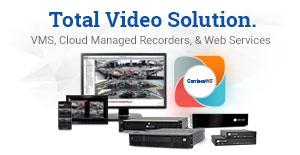Shifting Towards the Cloud – Dramatic Changes Bring Network Technology to the Forefront (Security Today, December 2018)

Video surveillance has dramatically changed in recent decades. Open, IP-based network technology has largely replaced the closed, proprietary world that long dominated the security industry. Megapixel has displaced analog technology as the most common choice for video surveillance cameras in both new projects and major updates to existing systems. Multi-sensor cameras have reduced the demand for PTZs and offer better overall situational awareness. The list goes on.
While other new technologies have been introduced by the video surveillance industry with varying levels of impact, another major shift is occurring almost unnoticed. Video surveillance is now in the early stages of a general move into the cloud.
Such a shift will inevitably lead to disruption of markets for long-time industry players and change how security operates at many levels. As with any successful new technology, the cloud brings great benefits and promise, as well as new challenges and a range of potential risks. Selection of the best architecture for the cloud, and the surveillance systems that use it, will be key to successful projects.
The Cloud and Video Surveillance
Cloud technology is not new. The IT industry has long adopted cloud-based services to reduce costs, improve resiliency, deliver new services, and increase customer satisfaction. Based on that experience, many vendors now provide a wide range of cloud-based services to the commercial, government, education, and consumer markets. Examples that may be familiar to the average security professional include Amazon Drive, Apple iCloud, Box, Carbonite, DropBox, Filesanywhere, Google Drive, IBM Cloud, Microsoft OneNote and many lesser-known products.
Much more recent is cloud technology’s growing acceptance across the security industry, especially for video surveillance applications. Security by its nature is conservative overall and slow to adopt new technologies, in large part as a natural response to reducing potential risk. But the benefits of the cloud for video surveillance are many.
A cloud-based surveillance system can reduce the amount of equipment and human resources needed onsite. Video can be recorded and uploaded over the Internet to another location, eliminating the need for significant and expensive local video storage. Security of the video data and the system can be enhanced. Staffing costs can be reduced since there is less equipment to manage and maintain, further improving ROI.
As an example, consider the use of cloud-based surveillance in a convenience store or a small office. Traditional systems are usually composed of an NVR or PCbased server under a counter or in a back room. The device would require basic administration from someone onsite. Video quality and system reliability is often poor, and the system may not have been professionally installed due to cost.
A small number of single sensor cameras is often sufficient for these types of minimal surveillance system requirements. By moving to a cloud-based application, no employee would be required to administer a local NVR or server; it would be managed and the video content accessed from anywhere. No technical expertise or training would be required locally, resulting in significantly lower cost. No employee could access the system inappropriately. Professional management of the video data would inevitably lead to higher reliability and more secure video protection at the same time.
The same model could be scaled out to a large number of cameras in a single project for superior coverage, or to multiple small projects in other locations that are aggregated together via the cloud. Video would be recorded locally and stored over the cloud to a professionally-managed data center, with IT-grade operational and security best practices. Such a facility would provide the best achievable uptime and responsiveness to any issues as they arise while providing significant improved ROI.
Challenges and Risks
When rolling out any new technology, there are always challenges and risks to be addressed. A long-time challenge to the first cloud deployments has been that security professionals are often unwilling to allow their video to be stored offsite. Instead, they have traditionally preferred to keep their video data “locked down” in their facility where they can physically limit and control access. Losing this level of physical control can be perceived to be a major issue.
However, this view is changing as cost benefits are better understood and security professionals become better educated about cloud technology. The increasing use of the cloud for ITmanaged corporate data and rising personal use of cloud services are also responsible for much of this gradual shift in perception.
Another concern is that video surveillance generates very large files, and the transfer and storage of such material can be quite costly. Most professional-grade megapixel security cameras today offer advanced compression technologies such as H.264 and increasingly H.265. Many camera vendors go further by offering their own technologies that reduce network bandwidth and video storage requirements. These techniques and technologies are especially important with the widespread adoption of multi-sensor cameras and the growth of 4K or higher megapixel technology for ever better surveillance coverage and image quality. While these factors all help, only by selecting what video is stored locally and what is uploaded to the cloud can the cost issue be most effectively addressed today.
Yet the biggest concern of today’s security professionals is cybersecurity. Highly publicized cyberattacks continue to plague electronic systems of all kinds worldwide, and only the most cyber- secure systems can be counted upon to adequately protect surveillance video.
In response to these valuable benefits and addressing justifiable concerns, many long-time video management systems have added remote access technology to their products and are increasing system security. Most VMS systems now allow remote access to the surveillance system, such as through an offsite PC or Mac, and increasingly through a smartphone or tablet app. Many also enable video to be streamed to additional locations for secure offsite backup or storage.
A few vendors now provide next generation products designed entirely from the ground up for the cloud. In these cases, video is captured locally through megapixel cameras, then uploaded to a remote storage service via the cloud, with various techniques employed to reduce video file size and network bandwidth. At present, these systems often are limited in practical use by the number of cameras that can be supported in a single location, but all show much promise for the future. A reasonable predication is that eventually, the most important video will be stored offsite using cloud applications.
The best solution at present may be a blended or hybrid cloud surveillance system. Such a hybrid offers both local and cloud recording. It starts with the traditional model, of recording locally on an NVR or server using the vendor’s video management system. This increases the reliability of recording and eliminates most performance, bandwidth, or cost issues that arise from continuously streaming all captured video over the internet to the cloud. The hybrid approach can allow for more cameras to effectively be used in a single location than a cloud-only solution might affordably deliver.
The local NVR or server plus the video and user accounts it contains can be managed remotely, over the cloud. This reduces or eliminates the need for local admins, providing major savings and reducing both complexity and risk of system compromise. No local programming is required, and only those authorized can access the system.
Important video, such as clips of activity or incidents, can be uploaded to the cloud for long term storage or sharing with multiple users—anywhere, anytime.
A fully-enabled thick client for laptops or desktops, a software- free thin client accessed from most popular web browsers, or a useful app on a smart phone or tablet are all that are required to access and use the system with a single sign-in regardless of platform.
Strong cybersecurity is key to the reliability and protection of both traditional and cloud-based surveillance, and may be lacking in many in-use systems today.
For new cloud-based deployments, use of two-step verification is a required first step. This security approach can be used to allow access the surveillance system or the video it contains, regardless of platform used. Having strong controls over who can see and do on the system is also a must-have.
Video to be shared from the cloud must be password protected with NIST-compliant data encryption for maximum security to ensure appropriate access. Each local VMS or NVR system must establish a trusted outbound connection to the cloud storage platform. This eliminates potential network vulnerabilities by eliminating need for any open ports through the network firewall. This capability will be appreciated by the IT organization, further reducing the risk to the entire network infrastructure versus traditional remote access methods.
Cloud-based systems that offer these types of protection, performance, flexibility, and cost savings are the next logical step as video surveillance and the security industry overall moves into this new age. Hybrid cloud solutions are available today from a select group of vendors, and offer much additional promise for the future through the power and potential of the cloud.
Source: Security Today
















